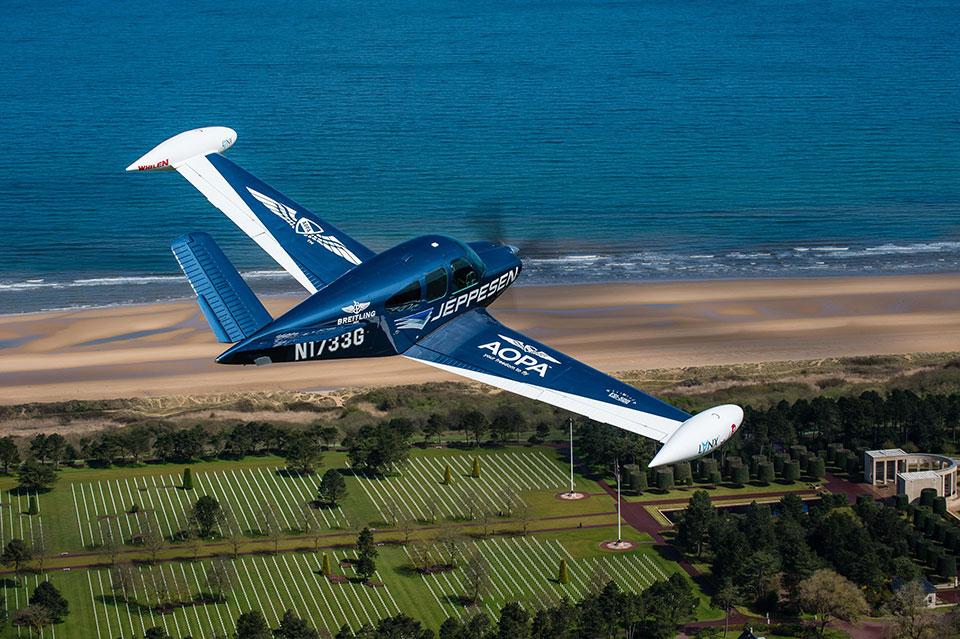Around the World Bonanza Pilot Endorses ADS-B
By Clif Stroud, FAA NextGen Reporting and Outreach
July 23, 2017 - Adrian Eichhorn is passionate about aviation. When he isn’t flying as a first officer with JetBlue based out of Boston, he’s flying his 1962 P35 Beechcraft V-Tail Bonanza at Manassas Regional Airport, close to his home in Northern Virginia.
Adrian, who was the 2016 FAA National Maintenance Technician of the Year, bought the Bonanza in 1988 and has completely rebuilt it over the years, doing most of the work himself. The effort included a completely rebuilt engine, a specially modified large cargo door, and a custom-designed avionics panel with automatic dependent surveillance–broadcast (ADS-B) “out” and “in,” because of its safety benefits.
“My passion in life is flying,” said Adrian, who is also an airframe and powerplant mechanic, and served as an engineer in the Army Corps of Engineers. Before signing on with JetBlue about 10 years ago, Adrian served as a pilot for the FAA, NASA, General Dynamics, and the Washington Redskins. He loves flying the Airbus A320 for JetBlue as much as he loves flying his personal aircraft.
Early in 2016, he completed a solo around-the-world trip in his Bonanza — a five-week, 163-hour voyage of more than 23,000 nm made possible by rigorous planning, reliable avionics with plenty of redundancy, and lots of help from friends. The longest leg, Honolulu to Oakland, took about 17 hours and was made possible by his tip-tank modification, giving him 200 more gallons of fuel. He overcame several challenges along the way: a nonfunctioning autopilot during one of the longest legs, a headset that did not work on one leg, and $26 per gallon fuel in the United Arab Emirates — plus a $1,000 “handling” fee in Dubai.
The flight was something he wanted to do for a long time. “You have things you want to do? Go do them,” Adrian said.
Speaking of getting things accomplished, Adrian urges his fellow pilots to equip with ADS-B as soon as possible.
“I looked at the capability of the L3 Lynx NGT-9000 ADS-B unit and realized I could get continuous subscription-free weather,” he said. “That’s unprecedented in a [general aviation] aircraft. Even though weather is available through Stratus on an iPad, having this subscription-free service and all the other products that are offered with ADS-B ‘out’ and ‘in’ — that’s priceless.”
The touchscreen Lynx NGT-9000 offers four models, each with a complete ADS-B package. The Lynx NGT-9000 series provide 1090ES (Mode S extended squitter) ADS-B “out” as well as 1090 MHz and 978 MHz (UAT) ADS-B “in.” This gives the pilot ADS-B traffic including automatic dependent surveillance–rebroadcast, a client-based service that relays ADS-B information transmitted by an aircraft broadcasting on one link to aircraft equipped with ADS-B “in” on the other link. The Lynx also has traffic information services–broadcast and flight information services–broadcast input.
The weather display includes METARs, AIRMETs, SIGMETs and NextGen weather radar information overlaid on a moving map. The unit also displays winds aloft, temperatures aloft, NOTAMs, and TFRs.
“The quality of the graphic display on the ADS-B unit is amazing,” Adrian said. “It’s full-color and very easy to read. Like most avionics on a general aviation aircraft, it’s small because of the limited panel space. But with Bluetooth, I can put the display on my iPad.”
Adrian is adamant that pilots should equip with the optional added benefits of ADS-B “in.”
“The ADS-B products enhance safety to the greatest degree I’ve seen since I started flying in the 1980s, not just the weather display you are given but the picture of traffic in the area, especially flying in and out of airports without radar,” he said. “For those pilots who only have ADS-B ‘out’ and not ‘in,’ they are really missing out.”
If pilots are waiting to install ADS-B because they think that the cost will come down any lower than it already is, he said that will probably not be the case. Adrian added that repair stations have become quite proficient with ADS-B installations, which minimizes aircraft downtime.
“Flying a general aviation airplane comes with a cost,” Adrian said. “You can’t put a price on safety. The cost of ADS-B is very reasonable for what you get. I personally would not wait. It’s making the entire national airspace system safer.”

